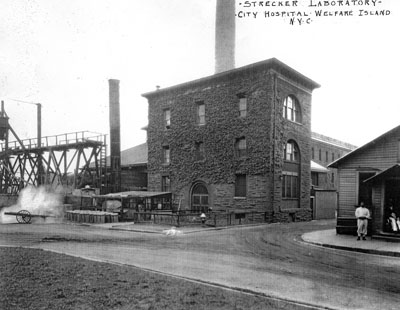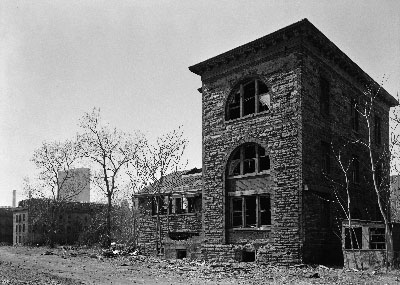
Strecker Memorial Laboratory
Landmarks Main > Strecker Memorial Laboratory
On November 25, 1975, the Landmarks Preservation Commission held a public
hearing on the proposed designation as a Landmark of the Strecker Memoral
Laboratory the proposed designation of the related Landmark Site. The
hearing has been duly advertised in accordance with the provisions of
law. Three witnesses spoke in favor of designation. There were no speakers
in opposition to designation. The representatives of the Roosevelt Island
Development Corporation have agreed to the designation.
Description and Analysis
 The
small Romanesque revival Strecker Memorial Laboratory is situated a the
southern end of Roosevelt Island between the Smallpox Hospital and Charity
Hospital, and provides an interesting contrast to them both in scale AND
style. Designed by New York architects Withers & Dickson and constructed
in 1892, it was administered under the direction of Charity (later City)
Hospital to conduct pathological and bacteriological work. The building
was the gift of the daughter of a Mr. Strecker, and as Dr., Charles G.
Child, Jr. wrote in his history of City Hospital (1904) it was "an illustration
of what lasting good an intelligent woman can do to perpetuate the memory
of a dear one."
The
small Romanesque revival Strecker Memorial Laboratory is situated a the
southern end of Roosevelt Island between the Smallpox Hospital and Charity
Hospital, and provides an interesting contrast to them both in scale AND
style. Designed by New York architects Withers & Dickson and constructed
in 1892, it was administered under the direction of Charity (later City)
Hospital to conduct pathological and bacteriological work. The building
was the gift of the daughter of a Mr. Strecker, and as Dr., Charles G.
Child, Jr. wrote in his history of City Hospital (1904) it was "an illustration
of what lasting good an intelligent woman can do to perpetuate the memory
of a dear one."
Pathological medicine made rapid advances during the 19th century, and laboratories such as this one reflect the increasingly scientific nature of its study and investigation. The Strecker Memorial Laboratory housed at the first floor a room for the routine examination of specimens, an autopsy room and a mortuary. At the second floor were rooms for more detailed research and experimentation. In 1905 the laboratory was remodeled, probably at the urging of the head pathologist Horst Oertel. Oertel was and emigre to this country and well acquainted with the pioneering work in pathology being carried on in Europe by such prominent individuals as Rudolf Virchow. The remodeling which included the addition of a third story to the laboratory, provided facilities for histological examination as well as museum and library space. In 1907 Oertel received an endowment for the Russell Sage Foundation, and the "Russell Sage Institute of Pathology" was first house in the Strecker Memorial Laboratory. When new facilities for this Institute were built, it moved while the Strecker Laboratory continued the pathological center for City Hospital and the City Home (formerly Almshouse).
Frederick Clark Withers (1828-1901) , the senior partner in the firm which designed the laboratory, as an Englishman trained in Great Britain, who came to the United States in 1852 at the invitation of the renowned American landscape architect, Alexander Jackson Downing. Unfortunately Downing was drowned that same year following the explosion off the steamboat Henry Clay. Withers then became associated with Calvert Vaux , Downing's former partner. In 1857 Withers was one of the first to be asked to join newly founded American Institute of Architects. Although he always retained this British citizenship, he volunteered for service in the Union Army in 1861. He returned home an invalid the following year, by recovered, and resumed practice in New York City , joining Vaux along with Frederick Law Olmstead in a partnership that lasted until 1871. In 1888 he formed a partnership with Walter Dickson (1834-1903). Together, as supervising architects for the Commission of Charities and Corrections, they designed several buildings on Roosevelt Island, among them Strecker Memorial Laboratory and three brick structures for the Almshouse. With his former partner Calvert Vaux, Withers had previously designed several buildings for the Commission of Charities and Correction, most notably the High Victorian Gothic Jefferson Market Courthouse, located in the Greenwich Village Historic District, which is the best known of Wither's New York City works. Among his other New York commissions were three commercial building at 448 Broom Street in the Soho Cast Iron Historic District, the high altar, reredos and robing room of Trinity Church, and the lich gate of the "Little Church Around the Corner" (Church of the Transfiguration). Primarily considered an ecclesiastical architect,. Withers published the influential book Church Architecture in 1873. The Chapel of the Good Shepherd of 1888-1889 on Roosevelt Island admirably illustrates his conception of church architecture. Walter Dickson who had practiced architecture in Albany for many years before coming to New York, designed the Albany Post Office and the Albany City Prison which replaced the original "Tombs."
The Strecker Memorial Laboratory, although small in size, is monumental in its overall effect. It is basically Romanesque Revival in style, somewhat in the manner of the late work of H.H. Richardson, as suggested by the broad arched openings and the use of rough-faced stone- gray gneiss, quarried on the island and used for many of the institutional buildings there. There use of contrasting orange brick for quoins, sting courses, t, and the arches gives the building a vivid polychromatic effect that is reminiscent of Wither's earlier compositions in the Victorian Gothic mode. Because of the change in the style from Gothic, which Withers generally favored, to Romanesque and because of the building type-non-ecclesiastic- it could be surmised that Dickson was largely responsible for the design.
 The
type of Romanesque Revival architecture which Henry Hobson Richardson
(1838-1886) developed became very popular among American architects in
the 1880s and early 1890s. Broad arches, rough stone facing., modest use
of polychrome, and the ASYMMETRICAL massing of elements are hallmarks
of the style. It was widely used for domestic, public and institutional
buildings. Montgomery Schuyler, noted 19th century architectural critic
felt that the Romanesque Revival offered a firm foundation of which to
build the elements of a "true and living architecture, such as for four
centuries the world has not seen." (Architectural Record I (October- December
1891). The Strecker Memorial Laboratory is designed in a late version
of the Romanesque revival characteristic of its date.
The
type of Romanesque Revival architecture which Henry Hobson Richardson
(1838-1886) developed became very popular among American architects in
the 1880s and early 1890s. Broad arches, rough stone facing., modest use
of polychrome, and the ASYMMETRICAL massing of elements are hallmarks
of the style. It was widely used for domestic, public and institutional
buildings. Montgomery Schuyler, noted 19th century architectural critic
felt that the Romanesque Revival offered a firm foundation of which to
build the elements of a "true and living architecture, such as for four
centuries the world has not seen." (Architectural Record I (October- December
1891). The Strecker Memorial Laboratory is designed in a late version
of the Romanesque revival characteristic of its date.
The building is T shaped in a plan with a curved vestibule at the south end. The main section of the building with skylighted flat roof was originally two stories high; the third story was added in 1905 by architect William Flanagan, Jr., and harmonizes completely with the original design. At the north end. The front is dominated by and arched entrance. The inscription "Strecker Memorial Laboratory" is executed in terra cotta on a plaque above the doorway. Flat brick arches and brick enframements accent the window on the front. The window treatment of the sides of the main section is most distinctive; at the first and second floors a single bold brick arch encompasses a triple window on each floor. A brick spandrel panel execute in a handsome basketwork pattern separates the windows between the two floors. Similarly, at the third floor a brick arch encompasses a triple window. This type of window treatment is reminiscent, on a smaller scale, of that used by H.H. Richardson in his design for the famous Marshall Field Wholesale Store in Chicago of 1885-87.
Another section with skylighted gabled room extends south from the high main section of the building. It is treated as one story above and elevated basement. Giving additional light to the large room on the upper level are long rows of windows on each side, set just beneath the overhanging eaves of the roof. This section terminates in a gabled south end with raking cornice. Filling much of the gable is a large arched opening subdivided into six vertical window units. This design is very similar to that of the windows in the side walls of the main one story projection cured vestibule with flat roof. Within are steps leading up to the large room at the upper level of this section.
The laboratory is an outstanding architecture composition with its find massing of elements of varying sizes effectively organized into a coherent whole. Equally striking is the functional use of materials where the rock faced local gray stone walls are contrasted with smooth orange brick trim. While small in size, it nonetheless achieves a remarkable sense of monumentality.